Education Corner
Structural Biology Pipeline Meets the High School Classroom
By Daniel Williams and Students Partnerships for Advance Research and Knowledge (SPARK) participants
For this feature, Biology Teacher Dan Williams has coordinated articles from the point of view of students and of teachers from Long Island, NY who are involved in SPARK (Students Partnerships for Advance Research and Knowledge), a collaborative program by the Office of Educational Programs and NSLS-II at Brookhaven National Laboratory (BNL).
At Shelter Island High School, Dan Williams’ courses include AP Biology, The Living Environment, and Marine Science. He can be contacted at dan.williams@shelterisland.k12.ny.us.
09/25/2019 Update
First Structure Released
The first structure from the program, a methylenetetrahydrofolate reductase (MTHFR) was made publicly available as PDB entry 6PEY. Learn more from the RCSB PDB News and explore the structure in 3D
Hypothesis-Based Structural Biology in the High School Classroom
Francesca Frasco7, Emma Gallagher7, Lauren Gurney7 Robert Bolen1, Kim Collins2, Erin Garland3, John Halloran4, Jocelyn Handley-Pendelton5, Victoria Hernandez6, Daniel Williams7, Dr. Aleida Perez8, Dr. Alexei Soares8 and Dr. Vivian Stojanoff8
1Eastport South Manor High School, 2Northport High School, 3Bay Shore High School, 4Connetquot High School, 5 Pendleton Hauppauge High School, 6William Floyd High School, 7Shelter Island High School, 8Brookhaven National Laboratory
High school students from Shelter Island High School (a small rural district on Shelter Island N.Y. nestled between the Twin Forks of Long Island) are using Protein Data Bank data to answer questions about methylenetetrahydrofolate reductase (MTHFR) (3FSU, 1ZP3), an enzyme implicated in many human diseases.
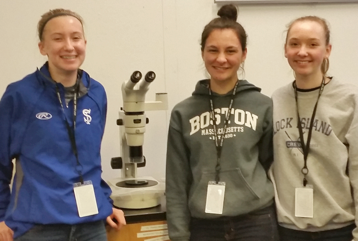
|

|
| L-R Lauren Gurney, Francesca Frasco, Emma Gallagher |
Students working at NSLS II Brookhaven National Lab |
Students Francesca Frasco (class of 2018), Emma Gallagher, and Lauren Gurney are part of a multi-year research class. They are examining currently published PDB structures in a program known as AutoDock Vina to generate potential positions for ligands. They hope to learn how the enzyme works and also to verify their docking hypothesis. To verify their hypotheses, the students are using X-ray diffraction data they collected from the National Synchrotron Light Source II, and comparing their physical crystal structure to the PDB model using the program Coot (Crystallographic Object-Oriented Toolkit). Student access to the synchrotron is possible through BNL’s SPARK program.
Students are also using PDB structures for in silico mutational structural analysis to understand how MTHFR diseases work at the molecular level with the hope of uncovering better treatment ideas.
Nothing about this project was easy; our unofficial motto became “One step forward–five steps back”, which the students state was one of the most valuable lessons learned. Real science is not done using quick cookie-cutter experiments with predetermined results; our project often failed, but we learned and grew from our mistakes. Francesca Frasco points out that “it took two whole years of banging our heads against the wall and learning a lot of programs by trial and error on our own to get where we are today.” We also had to build collaborative relationships with scientists and students from other districts to not only understand what we are doing but to ensure the validity of what we are doing.
Often, students think that science is a linear progression from brilliant hypothesis to brilliant results done by one individual in isolation. We have been working, failing, and changing course over several years in collaboration with BNL, Plum Island Agricultural Research Service, the University of Wisconsin, and several other Long Island high schools–not a linear progression and not in isolation. The collaboration with BNL and the other Long Island schools has enabled our school to have access to the NSLS-II and X-ray diffraction without which this project would just be theoretical.

|
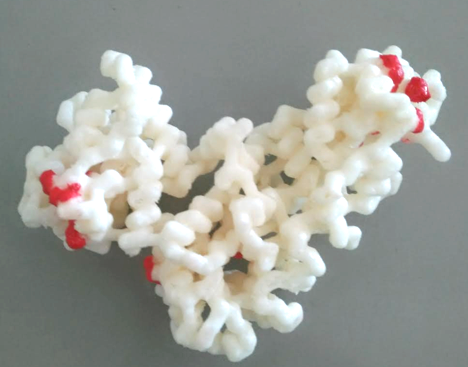
|
| Working in Coot |
3D Printed model of MTHFR from the .pdb file 3fsu |
Without the data from the Protein Data Bank none of this would have been possible. We learned about the structure of MTHFR by downloading the PDB data file and examining it in the 3D molecular viewer Jmol. We were able to simulate mutations by using the PDB file in silico with Discovery Visualizer. Discovery Visualizer also allowed the students to further examine binding chemistry, bond lengths, and atomic interactions. Finally, we were able to examine potential ligands using PDB data (both protein and ligand) in AutoDock Vina. AutoDock not only suggests binding pockets, but also provides calculated binding affinity data. Therefore, the students could analyze how well the potential ligand actually bound within the potential binding site.
We also used the PDB data file to 3D print MTHFR on a MakerBot printer. This was not only easy but invaluable in our understanding of how MTHFR works. Francesca points out “having this model helped me explain so many of my ideas. With this model I could actually point to a physical location and discuss how I think something would bind or interact.” We really did not understand the “barrel” configuration of the active site until we saw it printed in our hands. The 3D model was also a fun thing for the students to have; they are still bugging me about when they will get their own copy to take home.
Our project is not nearly complete as we have not achieved the threshold of “publishable results”...yet. However, the lessons learned by the students working on this long term project, with lots of success and failure and with the collaboration of multiple people, has helped my students understand how science works in the real world. The students learned valuable lessons in structural biology as well; they learned to use PDB files and various programs to create and test hypotheses on a computer. By using the PDB data, they also could visualize how proteins function and how mutations could adversely affect the function of an active site in three dimensional space, not by studying vocabulary from a book.
Acknowledgements
Thank you to the Office of Educational Programs and National Synchrotron Light Source II for their support. Thank you to Dr. Lisa Miller, Ms. Gretchen Cisco, and Ms. Gladys McKenzie and the user group. This work was supported by The Life Science Biomedical Technology Research resource, which is primarily supported by the National Institutes of Health, National Institute of General Medical Sciences (NIGMS) through a Biomedical Technology Research Resource P41 grant (P41GM111244), and by the DOE Office of Biological and Environmental Research (KP1605010). As a National Synchrotron Light Source II facility resource at Brookhaven National Laboratory, work performed at the LSBR is supported in part by the U.S. Department of Energy, Office of Science, Office of Basic Energy Sciences Program under contract number DE-SC0012704 (KC0401040).
Also thank you to Dr. Paul Azzinaro and Dr. Douglas Gladue from The Agricultural Research Service USDA at Plum Island, and Dr. Christopher Cunningham from Concordia University Wisconsin.
Determination and Refinement of the Crystal Structure of Proteins Block Allocation Group at Brookhaven National Laboratory
Robert Bolen1, Kim Collins2, Erin Garland3, John Halloran4, Jocelyn Handley-Pendelton5, Victoria Hernandez6, Daniel Williams7, Vivian Stojanoff8, Alexei Soares8 and Aleida Perez8
1Eastport South Manor High School, 2Northport High School,3Bayshore High School, 4Connetquot High School, 5Pendleton Hauppauge High School, 6William Floyd High School, 7Shelter Island High School, 8Brookhaven National Laboratory
Students and teachers from even Long Island school districts (Eastport South Manor HS, Northport HS, Bayshore HS, Connetquot HS, Pendleton Hauppauge HS, William Floyd HS, Shelter Island HS) are collaborating on the crystallization, generation of putative ligands, and elucidation of protein structures at the National Synchrotron Light Source II (NSLS II) at Brookhaven National Laboratory (BNL).
This collaboration is part of the SPARK Program, Students Partnerships for Advance Research and Knowledge, a collaborative program by the Office of Educational Programs and the NSLSII. The overarching goal is to provide students and teachers with authentic inquiry-based research to develop skills that promote success across all domains of science. Students and teachers learn how to crystallize proteins and use advanced liquid handling techniques to resolve novel structures and identify potential ligands. Through these hands-on experiences, they are also learning the fundamentals of x-ray crystallography. One of the goals of this collaboration is to contribute new structures to the Protein Data Bank.

|
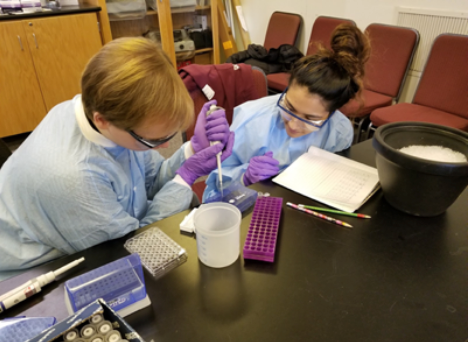
|
| Some of the program’s teachers clockwise from the middle Steve Leffler, Dan Williams, Robert Bolen and Victoria Hernandez |
Students performing crystallization experiments |
More than creating student researchers at the NSLS II, this collaboration increases student understanding of protein structure and function in biology. Structural biology; the study of proteins which includes their three-dimensional shape and function, is often an abstract concept that student’s express difficulty in fully understanding in spite of molecular visualization software programs. Although these software programs enable students to “see” the molecular structure, they often have no understanding how these structures were derived resulting in a limited basis for critical analysis. This collaboration helps solve that problem through student’s direct experience.
This project began with collaborative meetings between teachers, students and scientists to develop a competitive proposal for review. Students and teachers also gained experience in how science really works, it is not done in isolation but relies on collaboration. All work is the collective effort of the individual members; no one can succeed alone, the success of one is the success of all. This partnership between students, teachers and scientists has enabled students as users of NSLS II to obtain hands-on real-world experience in structural biology.
For the past year students and teachers from multiple districts gathered together at BNL to crystallize proteins under various conditions for examination by X-ray diffraction. Students and teachers had to learn how to problem solve and troubleshoot several hundred crystallization experiments that rarely worked as originally planned. Students and teachers experienced the success and failure of real science research and instead of being discouraged they eagerly kept coming back for more.
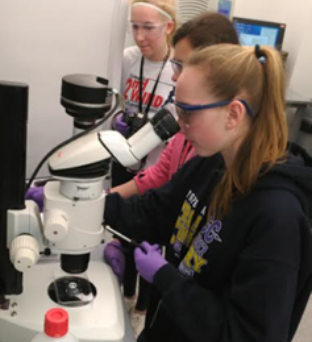
|
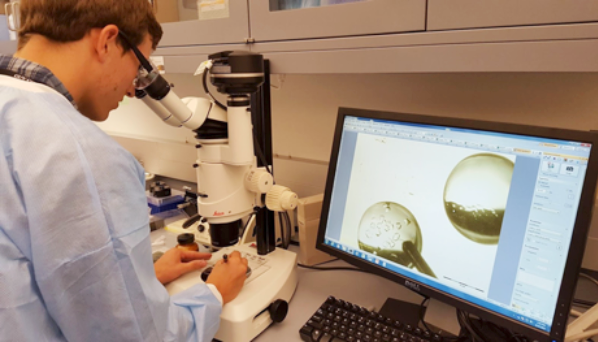
|
| Students evaluating crystal trays |
Student harvesting crystals |
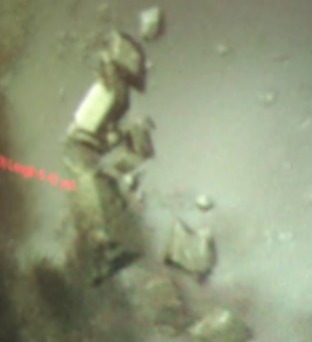
|
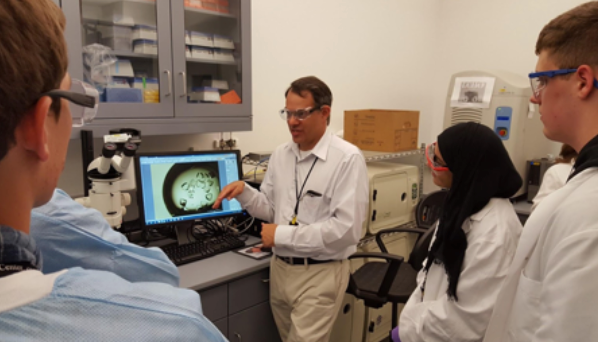
|
| Analyzing crystals |
Photo of crystals that were “fished” and used for X-Ray diffraction |
We were able to obtain X-ray diffraction data from our proteins this past spring and students across Long Island are now processing the data in multiple programs in CCP4 enabling model refinement in COOT. We believe we will be able to publish new structures in the Protein Data Bank shortly –stay tuned!

|
 |
| A screen capture of Model Refinement in COOT –resolving the experimental data with .pdb files |
Scientists and students analyzing data at the synchrotron |
Acknowledgements:
Thank you to the Office of Educational Programs and National Synchrotron Light Source II for their support. Thank you to Dr. Lisa Miller, Ms. Gretchen Cisco and Ms. Gladys McKenzie and the user group. This work was supported by The Life Science Biomedical Technology Research resource which is primarily supported by the National Institute of Health, National Institute of General Medical Sciences (NIGMS) through a Biomedical Technology Research Resource P41 grant (P41GM111244), and by the DOE Office of Biological and Environmental Research (KP1605010). As a National Synchrotron Light Source II facility resource at Brookhaven National Laboratory, work performed at the LSBR is supported in part by the U.S. Department of Energy, Office of Science, Office of Basic Energy Sciences Program under contract number and DE-SC0012704 (KC0401040).